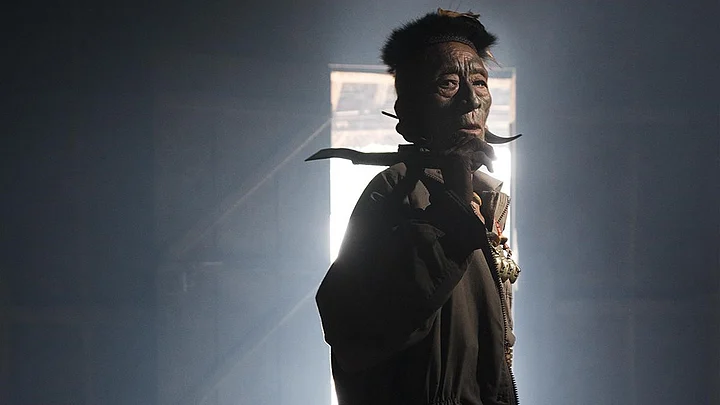The Longwa village is situated on the eastern edge of India’s north-eastern province of Nagaland. With Myanmar on one side and India on the other, this village is home to the fierce Konyak Naga Tribe.
Konyaks have been known as fierce headhunters for centuries until the 1970s. Killing an enemy and bringing back their head was considered a rite of passage and was rewarded by a tattoo on the face or the chest of the warrior.
Jewellery has also been a big part of their customs; the number of heads on a warrior’s necklace showed the number of people he has killed.
The leader of Ching Sha Morong Panpha, 86, has claimed 4 heads. He often struggles to come to terms with changes in the society.
The women on the Konyak tribe are known to carry children and bamboo containers on their backs. These containers are used when traveling through the rocky terrain to fetch clean water for the tribe.
In earlier times we used to hang the heads of our enemies on the walls of our houses, but now we are not allowed. So we have replaced them with the skulls of animals that we kill to provide for our family.Luhbong Wang, 76
Skulls and bones of buffalo, deer, boars, and hornbills still decorate the walls of every Konyak house, showcasing the pride and respect of the warrior. The skulls of captured enemies were also prominently displayed once as prizes from the generations of hunting days. But when head hunting was abolished, these skulls were removed from the homes and buried. Human skulls adorned the walls only as long as the Konyaks converted to Christianity.
Ching Kum, 86, hunted the last head in 1990 while fighting the Chang tribe. He is known for the last headhunting in the community.
Teihngam, 65, is the chief’s sister as well as a farmer. Her family would conduct ceremonies and make tattoos for the warriors who came back with heads. Those ceremonies along with traditional jewelry and clothes are fading customs within the tribe.
Spears were one of the weapons used during the hunting raids but are now something that the older men carry as a symbol of pride.
“Heads were to us what money is to your generation. They brought us respect and meant getting a better girl for marriage. And our tattoos symbolised our achievements”, says a member of the tribe.
If a warrior brought home a body part of the enemy, he would get a tattoo on his body. If he got a head, he would get one on his face, and once the warrior had 3 heads he would tattoo his neck to showcase his achievements.
So many new things are invented to create confusion. I used to like it when I was young and things were simple. I think even people coming to my village is destroying our village. We used to make our own medicine and there was a cure for everything.Tribe Member
The older males wear earrings made of boar horns and carry machetes, which they call daos.
Tribal members live within a very disciplined lifestyle where everyone in the community has strict duties and responsibilities.
The best is the past life. These days you say you don’t have any head hunting but you kill thousands of people a day. We killed 4-5 people a month for our rights. Now you kill thousands and still consider headhunting was bad.
Many of the tribe’s traditional practices and cultures have nearly vanished. The most feared warriors of yesteryears have almost diminished into just being a few old men with faded tattoos who can now be spotted smoking opium around the village, sharing stories about their glorious past.
My goal was to revive their sense of pride, by capturing their striking personalities and telling their story.
For more information about the writer log on to www.trupalpandya.com
